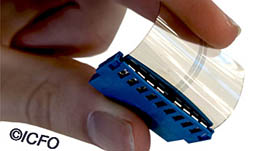SPIE Photonics Europe workshop to detail potential applications for faster computing speed, expanded data storage, enhanced medical diagnostics, more
 |
| Wearables similar to ICFO's prototype flexible 2D sensor above will enable health monitoring, among capabilities possible with future applications of graphene-based photonics technology. |
BELLINGHAM, Washington, USA, and CARDIFF, UK -- A daylong workshop at SPIE Photonics Europe in Brussels in April will present 12 research leaders from industry and academia speaking on prospects and potential for commercialisation of graphene technology. Workshop chairs are Frank Koppens of ICFO (Institut de Ciències Fotòniques, Barcelona Institute of Science and Technology) and Nathalie Vermeulen of B-PHOT (Brussels Photonics Team, Vrije Universiteit Brussel).
SPIE Photonics Europe will run 3-7 April in the Square Brussels Meeting Centre, with the graphene workshop on 5 April. Pre-registration is required for the workshop, and seating is limited.
"Graphene-based photonics technology promises a radically new set of capabilities to meet pressing future needs," said SPIE Science and Technology Director Bob Hainsey. "Among its wide-ranging applications are expanded communications networking and data storage, increased computing speeds, enhanced disease control utilising increasingly larger and more complex data sets, and more accurate fire, motion, chemical, and other sensor systems."
The workshop, featuring leaders in graphene technology from many leading university and industrial labs, will provide those attending with valuable insights on the latest research and inspiration for developing new products and capabilities, Hainsey said.
A rapid-presentations panel at the end of the day will feature industry leaders discussing next steps and challenges in commercialising graphene-based technologies.
Among the workshop speakers:
More information about the potential of graphene and other 2D technologies is at:
About SPIE
SPIE is the international society for optics and photonics, an educational not-for-profit organization founded in 1955 to advance light-based science, engineering, and technology. The Society serves nearly 264,000 constituents from approximately 166 countries, offering conferences and their published proceedings, continuing education, books, journals, and the SPIE Digital Library. In 2015, SPIE provided more than $5.2 million in support of education and outreach programs. www.spie.org
Contact:
Amy Nelson
Public Relations Manager
amy@spie.org
+1 360 685 5478
@SPIEtweets
All photos © SPIE, the international society for optics and photonics, except where noted.